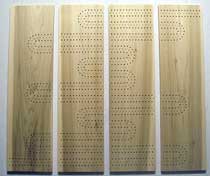
[ed. note: this is part two of an email Q&A I conducted with self-taught artist and DC-area blogger JT Kirkland, founder of Thinking About Art blog. See part one here. Part three follows next.]
RF. I love that you take wood, something organic, although in the case of lumber, it’s been denatured and turned into something else, then you apply patterns that evoke minimalism but also organic shapes and rhythms. What’s your relationship to wood?
JTK. You’re dead on! Boards of wood, such as the ones you might purchase at Home Depot or a lumber yard, are about as close as you can get to nature, but not nature. I’m not Andy Goldsworthy working outside. I’m not planting trees in a gallery. Quite simply, wood is very natural but full of beauty. (top image is “Switchback,” and below is detail)
RF. are you a power tool person? Do you have a favorite lumber purveyor?
JTK. I’m definitely a power tool person! I couldn’t imagine drilling the number of holes I drill with anything but a powerful hand-held drill. The vast majority of my wood comes from Home Depot and most of my tools come from there or Sears. I like the idea of using materials that anyone has access to and that millions of people walk right by each day but don’t recognize the potential. When you walk by a tube of oil paint in an art store, you think of painting and nothing else. Wood from Home Depot is much different and alludes to all sorts of craft activities.
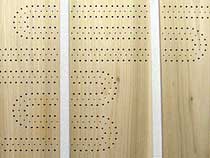
RF. tell a little about your wood selections — poplar for some, maple for some,cedar…also, what’s the thickness of the pieces? there’s no third dimension listed on the price list…are they 1/4” or 1/2 or does it vary?
JTK. The selection of wood is easily the most critical step in my process. I don’t pick “maple” or “poplar” or whatever type of wood. I pick paintings. About once every two weeks I visit some of the nearby Home Depots and rummage through all of the stacked wood. I look and look until a piece of wood calls out to me as art. The grain and coloration has to speak to me. I don’t have any idea of what the hole pattern will be or what the size and orientation of the composition will be. But I know I want to work with that piece of wood. It can be maple, poplar, or cedar… it just has to work. Frequently the wood I choose is “reject” wood, and what I mean by that is that your typical furniture maker or woodworker would never use the wood I pick. The grain is too colorful or “ugly.” Think of the furniture around you… how noticeable is the grain?
In terms of thickness, the wood itself is standard thickness. However, I mount the pieces on slats which can be up to 1” thick. I love how this pushes the work off the wall and gives it a great presence. It makes the piece become an object… an artifact.
RF. Do you know how to sew? Because the repetition of hole-making coupled with the patterns you make — which carry over among several pieces of wood — remind me embroidery or stichery. So that the pieces become quilts of a sort.
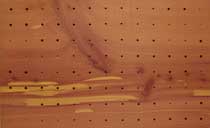
JTK. I don’t know how to sew but this observation is key! The connection to quilts is that the stitching joins the pieces of the quilt into one overall work. On a piece with 3 panels I see 6 works of art. Let me explain. You have 3 individual panels that operate as individual pieces of art. Each panel could be considered individually. Then you have the 3 pieces of wood considered as one work of art, separate from the holes. I then see the holes which would be on the 3 panels. I think you can look at just the holes across the 3 boards as one piece. And last but not least is the overall work: 3 panels of wood and holes. (image above is “Woven” and below is detail)
RF. The sizes are idiosyncratic. are the pieces dictated by a certain
idea about size?
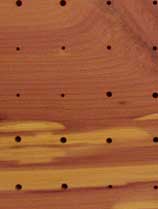
JTK. The sizes of my work very often mimic typical canvas sizes and proportions. It’s the size, proportion and mounting on the wall that drives home the idea of painting. I think by placing the work anywhere else (the floor as one curator suggested I do), it immediately becomes sculpture and loses the connection to painting and drawing. I like that the size and composition keep the possibilities open as to what it can be.
Rf. i can’t tell what the finish is on them. are they stained and oiled?
and how are they affixed to the wall?
JTK. My work does not use stains or oils. I’ve experimented with stain but found that it hid the grain too much and made the wood artificial. And it wasn’t necessary… natural is where it’s at. About half the pieces have no finish at all. The other half have a clear lacquer on them. I’ll put lacquer on the work only if it enhances the grain. On some types of wood (Fiddleback Maple, for example), the lacquer really makes the wood pop. But it doesn’t hide the grain… and that’s critical. Stain often takes the character from the wood, and obviously we can’t have that in my work. Furniture making? Maybe. But not my work.
RF. what size drill bit do you use?
JTK. I have 15 different sizes of drill bits that I can use. This allows for greater flexibility in the hole pattern and effect.
RF. I think it’s hysterical that you include “Holes” in your list of materials on the price list for the show…
JTK. I’ve gotten many questions about including “holes” in the list of materials. The reason is twofold. 1) In jpegs it is tough to tell that they are holes and not painted circles. 2) I really believe it’s a medium, even if that idea is strange. It’s a space… nothing. But it has a definite presence. It does work. If I painted the circles with oil paint, no one would have a problem with me listing oil paint. But in this case, the holes have a greater impact than oil paint would and deserves to be called out.
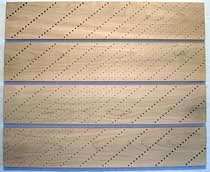
Furthermore, the holes are key in driving home the idea of depth. It’s very literal. The other depth is seen in the grain. On the sides of my pieces you can see that the grain moves “through” the wood. The color and lines can be seen on the other side of the board. Though it appears to exist on the surface, the material is truly made of the color and grain. This idea sort of calls to the Color Field painters who tried to make the color and canvas act as one thing. Wood does it naturally. (image is “Valley” and below is detail)
RF. I haven’t seen them in person but my impression is that the space in between the planks feels like a gash in the whole —
almost like a wound, a symbolic sundering of what should be a unity.
JTK. In terms of violence, while I don’t see it or think about it in the gaps, I do think about it in the holes. It’s such a violent process to cut and drill through the wood. It’s all about strength in making the work. But with each step of the process it calms down. I use a belt sander to smooth the wood. I then use a block sander. Then just sandpaper and my hand. Lastly I wipe the work down with a tack cloth. I go to great extremes to make the work look safe and clean… but it’s anything but.
RF. Do you think of these as stripe paintings?…the wood grain is painty and the black shadows are stripey.

JTK. Ah, you touch on it here. First and foremost I consider my work to be painting. Sure, there’s no oil or acrylic paint. But whatever is in the wood and produces the color in the grain is paint to me. So in essence I consider this found painting… found in nature. Secondly, I think there’s clearly some sculpture in the work. And lastly, there’s a bit of drawing involved (my work was recently included in a National Drawing show). I just can’t fit my work into any particular genre… it’s all of the above.
I’ve never thought of my work as stripe paintings, but the black shadows in the gaps between the pieces play a big role in the compositions. They are a big part of the composition and breaking the image up. The puts a big reliance on the holes to re-unite the piece… as if the arrangement of wood tore it apart and the holes put it back together again. I also think the shadows provide a background that makes the wood pop off the wall. It gives the work added depth… like graphic designers use with text that has the shadow behind it.









